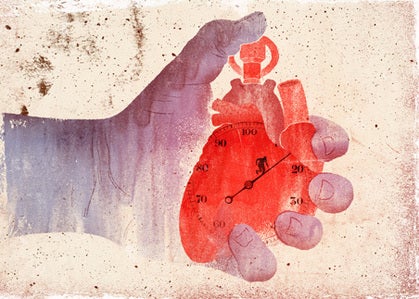Hill Therapy

How to train for trail-running’s ups and downs
The feel of your heart pounding in your chest at the top of a hill attests to the conditioning hills provide for …
Illustration by Kevin Howdeshell
The feel of your heart pounding in your chest at the top of a hill attests to the conditioning hills provide for your cardiorespiratory system. But they also provide a great workout for your skeletal muscles. Both uphill and downhill training increase leg muscle power, can be used as a transition into more formal speedwork, improves the performance of the heart and uses the leg, arm and trunk muscles differently than flat running. For trail runners, hills are the place where you can make up the most time in a race.
Why Down Is Harder than Up
If you have ever run a race with long or steep downhills, you know how downhills can trash your legs. Even though running uphill feels harder since your heart must do more work to send blood and oxygen to a large muscle mass working against gravity, downhills cause the biggest impacts on your body.
gravity-induced eccentric muscle contractions force your muscle fibers to lengthen, causing them to tear. Fewer muscle fibers are active compared to other types of muscle contractions, distributing the generated force over a smaller area of muscle and resulting in even more damage.
The forces of impact and braking are also greater during downhill running compared to uphill and flat running, increasing the risk of overuse injury. The muscle damage decreases your muscles’ ability to produce force, which slows your pace on the flat and uphill portions of the race and leads to delayed-onset muscle soreness, which includes an inflammatory response and lasts for a few days following the race as your muscle fibers heal.
The good news is that the damaged muscles heal back stronger, protecting them from future injury. Running downhill has a prophylactic effect on muscle damage and soreness. While you can expect your muscles to ache after the first time running downhill, subsequent downhill workouts will cause less soreness.
Downhill running also affects running economy, the amount of oxygen you consume to maintain a given submaximum pace. A number of studies have shown a significant decrease in running economy for up to one week following a 30-minute downhill run on a 10- to 15 percent grade.
Hill Training ABCs
When running hills, follow these guidelines:
• Since you are running relatively slowly on hills even though you’re working hard, the exact pace is not as important as the effort. Aim for a specific effort rather than a specific speed. Monitoring heart rate with a heart rate monitor is a great way to make sure you are working hard enough and maintaining an even pace.
• To increase VO2max, run up a hill that takes at least three minutes to climb. If run at about 5K race-pace effort, your heart rate, stroke volume (the volume of blood pumped by the heart per beat) and rate of oxygen consumption can rise to their maximum values. (In a laboratory setting, the VO2max test is almost always performed using an increase in treadmill grade as a way to use more muscle mass and force runners to reach their VO2max.)
• When running downhill, shorten your stride to prevent overstriding and emphasize a quicker leg turnover. It should feel like controlled falling.
• Given the stressful nature of downhill running, treat downhill workouts as hard sessions and allow two to three days of easy running afterward. Back off the hills in the final couple of weeks before a race.
• Incorporate downhills into training slowly. Start with a short, gradual slope of about two to three percent, and progress to steeper and longer descents.
• Since you are running faster on downhills than flats or uphills, there is less time to decide on foot placement, so look ahead several steps.
Dr. Jason Karp is a nationally-recognized speaker, writer, and exercise physiologist who coaches runners of all levels through RunCoachJason.com. He holds a Ph.D. in exercise physiology and is founder and coach of REVO2LT Running Team. He is also author of 101 Developmental Concepts & Workouts for Cross Country Runners.
Get Hill Strong
Warm up and cool down before and after each workout.
- Hill Run. Do a basic trail run of 4 to 8 miles that includes hills of varying lengths and grades.
- Long Hill Repeats. Run 5 to 6 x ½-mile uphill (5- to 8-percent grade) at 5K race-pace effort with jog back down as recovery.
- Short Hill Repeats. Sprint 8 to 10 x 100 meters uphill (15- to 20-percent grade) with jog back down as recovery. Exaggerate your arm swing, lean into the hill and focus on pushing off the ball of your foot.
- Uphill-Downhill Repeats. Run 4 x ½-mile uphill + ¼-mile downhill (2- to 3-percent grade) at 5K race-pace effort with three minutes jog recovery.
- Short Downhill Repeats. Run 8 to 10 x 100 meters nearly all-out downhill (2- to 3-percent grade) with jog back uphill as recovery.
- Hill Accelerators. Run 4 to 8 x 200- to 400-meter hill. Start with a 200-meter flat section at race pace, then run the bottom of the hill at race-pace effort and accelerate the last 50 to 100 meters, with jog back down as recovery. The focus of this workout is the acceleration at the top of the hill, which is opposite of the recovery that runners naturally want to take at the top of a hill. Pump your arms to help you accelerate and lengthen your stride.
- Hill Bounding. Using an exaggerated running motion, bound 6 to 8 times up a steep hill (15- to 20-percent grade) for 40 to 50 meters and jog back down. Try to achieve as much horizontal distance with each bound. Focus on fully extending the push-off leg and driving the knee of the forward leg up.